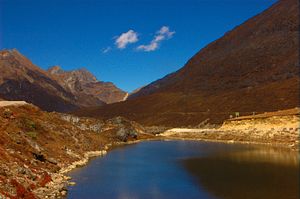The residents of the “orchid state” of India, Arunachal Pradesh, will remember May 21, 2018, for a very long time. A wartime airstrip that was laid down 66 years ago was put to use again. The state’s ruling Bharatiya Janata Party (BJP) is taking credit for being the wind beneath the wings of the “first commercial flight landing” there, a 19-seat aircraft called Vayudoot operated in some of the state’s airstrips — including in Pasighat — for civil passenger services, until 1990. The 46-seat ATR-42 aircraft of Alliance Air — a subsidiary of the state-owned Air India — landed in India’s northeastern-most town of Pasighat, which lies in the foothills of the Himalayas and at 155 meters above mean sea level.
Itanagar, the capital of Arunachal Pradesh, doesn’t have an airport: the plan to develop one is mired in land acquisition issues. The seven states in India’s northeast, which are separated by the so-called “Chicken’s neck” from mainland India, are best served by the airport in Guwahati, which is the capital of Assam. Five other airports and helicopter services operate in this vibrant and diverse region of the country. It is in this context the Alliance Air flight bears significance.
The re-opening of the Pasighat airstrip is part of India’s UDAN scheme — the acronym means “flight” in Hindi — that was launched last year, which aims to connect at least 75 airports in smaller cities to major hubs by affordable air travel. But can the foray into Arunachal Pradesh, although not yet with a private airline, be written off as a flight of development fancy by the current government?
The plan seems logical on paper: with more disposable incomes and a relatively lower cost of travel than in other countries, Indians are flying more, and with more family members migrating to other parts of the country, air travel is no more reserved only for emergency purposes.
However, that the Hollongi airport near Itanagar is still waiting to be developed since it was announced a decade ago is symbolic of a larger issue in how successive governments have viewed the idea of development in the Northeast. The state’s chief minister, Pema Khandu, hasn’t minced words about converting the state’s oil and coal reserves toward revenue-generating activities.
Meanwhile, the Dalai Lama’s visit to the Tawang Monastery in the state in April raised concerns in the aftermath of the resignation of the monastery’s abbot, who found himself at the center of an anti-dam protest that turned violent. One monk from the monastery had been spearheading protests against the large hydro projects coming up in the ecologically sensitive region. The protest following his arrest turned violent and led to the death of two people. As was reported in The Wire, “Taking an anti-dam stand in Tawang also meant he [the monk] was taking on the most powerful political family in town – the family of present chief minister Pema Khandu. The Khandu family has considerable interest in the hydel projects of Tawang and elsewhere. All the three ministers of Tawang are from the family.”
Apart from the case of the hydro power projects, in which signatures of villagers agreeing to the projects were allegedly fraudulently obtained, the issue of development and its beneficiaries has long ailed the region. According to Sangeeta Barooah Pisharoty, a senior journalist at The Wire, who has been extensively reporting on the northeast region, the promise of jobs in lieu of their land has only meant petty jobs as security guards, which has resulted in large-scale migration from the region to the rest of the India.
Even though China claims most of Arunachal Pradesh as “South Tibet,” and occupied it during the 1962 war, the reawakening of the Pasighat airstrip could also be viewed as India’s desperate attempt to have its borders demarcated and its dominance felt. But on the other hand, if “development” – the carrot that has appeased the region such that ministers swung from one party to another – means creating more jobs, it also means that concerns of the state’s 26 diverse tribes and their concerns with relation to land holdings have to be dealt with carefully.

































